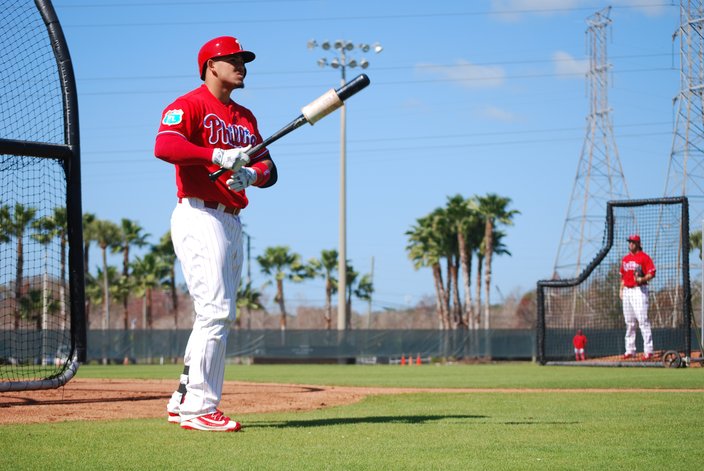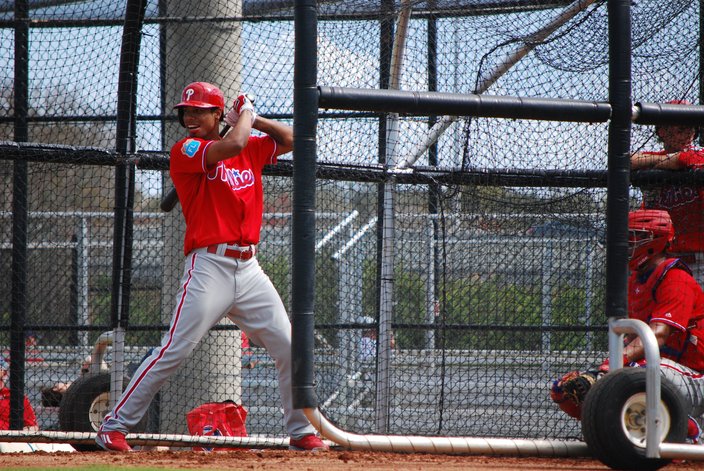
February 10, 2017
The first-year hitting coach peered over across the diamond to the adjacent field to take stock of one of his many pupils already at work in Clearwater, Fla.
Matt Stairs, the only player from the 2008 World Champion Phillies that will wear the team’s uniform in 2017, albeit as a member of the coaching staff, watched Nick Williams, a mercurial outfield prospect who came to the organization in the blockbuster trade that sent World Series MVP Cole Hamels to Texas.
“He still has a leg kick, but I watched him today and he had a quiet leg kick, what we call a quiet load,” Stairs said in a phone call shortly getting off the field Thursday morning. “The front foot was coming down, but there was no head movement, so now you have complete control of the strike zone and you see the pitches better. You notice if it’s an off-speed pitch, you notice if it’s a fastball away. The quieter your body is, the more hands you use, the more vision you have of a ball coming in because it’s not bouncing around.”
Stairs, who played in the big leagues for 19 years, will have his work cut out in his first season as a coach.
The Phillies had the worst offense in baseball last year (last in runs scored and OPS, second-to-last in OBP). They also had the worst OPS in Major League Baseball in 2015 and the second-lowest OBP. The Phils haven’t had a team OBP north of .306 since the 2012 season.
With that said, there are plenty of areas where the team could stand to improve, perhaps most obviously with the young and developing players who already have a decent chunk of big league time. And with an outfield that, beyond Odubel Herrera, has been downright dreadful during the aforementioned four-year period.
But, as the Phillies move into Year Three of their rebuild, the single most important thing they need to happen, in order to see that rebuild through and return to regular contention, is for a handful their growing group of prospects to hit.
And “hit” works both ways: both in the baseball jargon regarding prospects (think of holding a lottery ticket, and hoping at least a couple of your numbers match the winner) and in the literal sense (you know, they reach base enough to keep a regular job in the big leagues upon arrival).
Jorge Alfaro hit .285 with a .783 OPS in 97 games at Double-A Reading last season. But he's also struck out 597 times (with just 117 walks) in 550 minor league games.
In order for the Phillies to get where they want to go, they need J.P. Crawford to not be Domonic Brown, and need a few guys from collection Williams, Jorge Alfaro, Dylan Cozens, Roman Quinn, and Rhys Hoskins (among others) to pan out, in addition to the young prospects further down on the farm (like Mickey Moniak and Cornelius Randolph). The odds are against everyone succeeding, but among that group, the organization absolutely has to churn out some productive major league regulars.
“Expectations this year? It’s like everybody, it’s to make it to the big leagues and stay here,” said Alfaro, who got a brief taste of a big league clubhouse in the final five weeks of the 2016 season. “But wherever I go I’ll just keep working hard, keep playing hard, and try to stay healthy.”
Alfaro, 23, also arrived to the Phillies a year and a half ago in the Hamels trade. He is expected to begin the season at Triple-A, along with the 23-year-old Williams.
If the Phillies want to look back one day and truly say they “won” the Hamels trade, they are going to need at least one of those guys to fulfill their potential and turn into big league regulars. But that’s unlikely to happen in the first couple months of the 2017 season, or at least until both Alfaro and Williams improve their skill sets as hitters.
Alfaro, who hits from the right side, certainly did not have a bad first full year as a Phillies prospect: he hit .285 with a .783 OPS, and 15 home runs in 97 games at Double-A Reading.
But he also struck out 105 times in 435 plate appearances and walked just 22 times. In seven minor league seasons, Alfaro has 597 strikeouts and 117 walks in 550 games.
The left-handed-hitting Williams did have a down year in his first full season in the Phils’ system, batting .258 with a .287 OBP in 125 games at Triple-A Lehigh Valley. And, like Alfaro, he collects a lot more strikeouts than walks (136 K, 19 BB in 527 plate appearances).
Williams had just one walk in 46 games after the All-Star break last summer and has compiled 373 strikeouts and 76 walks in 356 games in the last three years.
“It’s really hard,” Alfaro admitted last month. “You just have to keep working hard at it and try to get better. I know I can get better just by talking to (Stairs), and with my manager. … I would say it’s about learning the strike zone better. It’s not always about being aggressive or being patient, it’s just about learning the strike zone.”
According to Stairs, it could very well be as simple as correcting mechanics. Both hitters (and the first-year hitting coach) have already been hard at work at the Carpenter Complex, where the Phillies will hold their first full-squad workout on Thursday.
Stairs first began working with Alfaro in January, when the budding catching prospect was at Citizens Bank Park for the Phillies annual prospect seminar.
“It’s all mechanics,” Stairs said. “You’re not changing their swing. You’re changing your swing path. You’re taking the same exact swing, and what we worked on (back in Philly), and what we’ve worked on since he’s been here is, think about getting jammed. Which causes you to stay back a little longer and recognize the pitch. And then trust your hands by throwing them at the barrel.”
Alfaro was relying too much on his upper body and not putting enough trust in his hands, according to Stairs.
“Alfaro is a guy who is so strong that he wants to swing at everything with his upper body, and he would leak and his left shoulder would leave the zone and the next thing you know the strike zone changes, because all of a sudden he didn’t have that plate coverage outside, he didn’t recognize the pitch if it was 4 inches outside or if it was 8 inches outside,” Stairs said. “It all looked the same because his head never stayed on top of the baseball coming through the zone.”
And with Williams? Stairs had a somewhat similar diagnosis: his mechanics (beginning with a hard leg kick) weren’t giving him a long enough time to recognize the pitch.
Nick Williams stumbled in his first full season with the Phillies in 2016: he had 136 strikeouts in 125 games at Triple-A and, after the All-Star break, had just one walk in 46 games.
“He dives so hard with his front foot, that he would take pitches in batting practice and ask the (batting practice) coach if it was a strike or not,” Stairs said. “Which tells me that there’s way too much head movement. So he would be so hard on his front foot when he landed that the strike zone would change because his head was moving, literally, 12 to 16 inches.”
So Stairs began a fun drill: he asked Williams to take some dry swings but stuck his own foot down where Williams’ metal-spiked cleat would land.
“I say, ‘Step on my foot. You don’t want to hit my foot, do you?’” Stairs said. “So they rely on stepping soft onto the foot, which causes them to stay back. Their head’s not moving anymore. And all of a sudden, you’re taking the exact same swing. So we’re not changing the swing, we’re just taking the pattern or the path of going to a baseball and going through it, compared to attacking the ball.”
Stairs is a big believer in having his hitters stand in the box during pitchers’ bullpen sessions, so they can mimic taking a pitch and, thus, improve their own pitch recognition. As with a pitcher's goal in the same side session, repeating his delivery, it’s all about repetition and training your body over and over until it becomes natural.
Neither Alfaro nor Williams are going to become walk machines overnight and they probably aren’t even likely to become the disciplined hitter Stairs was (a career .356 OBP) in his own career. But if they’re able to cut down they strikeouts by, say, a couple dozen in 2017, and learn to take more regular walks, each will take important steps as prospects with realistic paths to the Phillies lineup.
“Yeah you can’t change a tiger’s stripes,” Stairs said, “but maybe you can take a couple stripes away from him. And just get him into a good hitter’s position.”
 Ryan Lawrence/PhillyVoice
Ryan Lawrence/PhillyVoice Ryan Lawrence/PhillyVoice
Ryan Lawrence/PhillyVoice